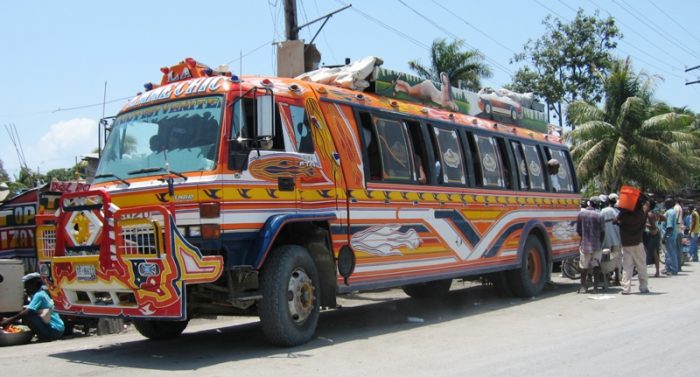What Haitian bus drivers can teach us about branding

Buying stuff just ain’t what it used to be. More than ever, personality and genuineness feel like secondary values, and that influences the quality of the things we have to buy. Whatever is left of a beautiful idea once it emerges from the mass-marketing wringer is often a mere shell of its original self. Real art, sadly, doesn’t sell very well in America.
But it does in Haiti. At the very heart of the country’s transportation system is the tap tap bus, a sort of shared taxi that’s a veritable painting-on-wheels. Covered in gorgeous murals, tap taps are spectacularly decorated with artists’ handiwork featuring local and international celebrities, from rap stars to a driver’s own mother-in-law, religious imagery, music, and vignettes of daily life, all splashed in bright, bold primary colors.
These tap taps don’t just sit there looking pretty though. They’re actually successful, independently owned businesses, with drivers that spend a good deal of the income they make on repainting. And that’s not cheap — some drivers spend upwards of $1,200 a year to keep their buses in artistic shape.
So what is it about these buses that brings in business? There are plenty of other trucks and vans in plainclothes looking for passengers to pick up, so why would someone choose a tap tap? For some, flashy means functional, as many passengers associate the more artful buses with better upkeep. After all, if a driver has enough money to paint a detailed portrait of Tupac on the side of his bus, that can only mean he spends as much on the brakes and suspension, right?
But there’s a more important reason they earn recognition and pull in more fares than undecorated buses: they’re just beautiful. Port-au-Prince is overrun with genuine works of art ferrying people throughout the city, and most are filled to capacity.
So which mode of transportation would you rather take: A sad, empty brown van … or a party bus painted like a musical rainbow?
I’m willing to guess that the average bus driver in Haiti doesn’t know much about branding, and that might be a good thing. In fact, tap tap buses represent what branding COULD be. They’re not some gimmick cooked up by advertising people. These drivers don’t ask their friends what to paint on the bus, and they don’t do focus groups or test marketing. They find an artist they like, they give him their vision, and that’s what comes out. It’s simple human to human communication, and that translates to the bus itself.
Meanwhile, we put Chicken McNuggets on the sides of our buses.
The more you hack away at a creative endeavor, and the more you give in to allowing other people to whittle it away and contort it to fit research polls, taste trials or some silly demographic analysis, the more corporate and stale and generic it becomes. The more you try to tailor it to what you think other people want, the less unique and authentic it will be.
Beautiful things have value because they are beautiful, and that’s what makes them work. Because people know when they’re being sold to. They know what plastic tastes like. So why dilute brilliant ideas to the point where we know they exist solely to be bought and sold? Build intelligent, useful, beautiful things for those intrinsic values and they will sell themselves.
The US State Department warns travelers not to use tap taps “because they are often overloaded, mechanically unsound, and driven unsafely.” Well you know what? So is art. It’s dirty and moving and unsafe and the wheels could fall off at any moment, but that’s what makes it such a good ride.
Imagine a world where you don’t have to go to a museum to appreciate art. Instead, it’s waiting for you at the bus stop.
